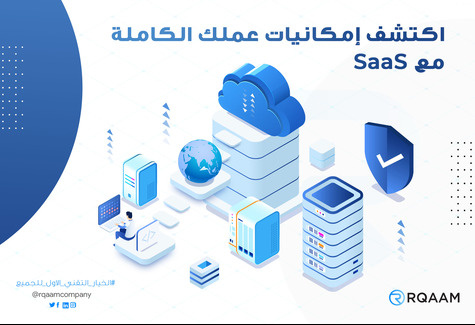في المشهد الرقمي المتطور باستمرار للقرن الواحد والعشرين، تسعى الشركات باستمرار إلى البحث عن الأدوات والاستراتيجيات المناسبة للبقاء في المقدمة. لعبت خدمة البرمجيات كخدمة، المعروفة باسم SaaS، دورًا كبيرًا في هذا التحول. إذا كنت تسعى لتحقيق ارتفاعات جديدة في عملك، فقد يكون SaaS هو المفتاح الذهبي لاكتشاف النجاح الغير مسبوق.
ما هو SaaS؟
في جوهرها، SaaS هي خدمة مستندة إلى السحابة حيث بدلاً من تنزيل البرمجيات على جهاز الكمبيوتر المكتبي أو شبكة الأعمال لتشغيلها وتحديثها، تستخدم متصفح الإنترنت بدلاً من ذلك للوصول إلى البرنامج. تطبيقات مثل Google Workspace وDropbox وSalesforce والعديد من التطبيقات الأخرى هي أمثلة على منصات SaaS.
لماذا هو SaaS المفتاح لاكتشاف إمكانيات الأعمال؟
1. تكلفة فعالة:
تقلل تطبيقات SaaS من تكلفة ملكية البرنامج من خلال القضاء على الحاجة إلى الطاقم التقني للتعامل مع التثبيت والصيانة والترقيات. لا مزيد من التكاليف المقدمة الضخمة؛ الشركات تدفع فقط مقابل ما يستخدمونه، عادةً عبر اشتراك شهري أو سنوي.
الوصول في أي وقت ومن أي مكان:
مع SaaS، لست مرتبطًا بمحطة عمل معينة. طالما كان لديك اتصال بالإنترنت، يمكنك الوصول إلى البرنامج من أي جهاز، في أي مكان في العالم.
2. ترقيات سلسة:
تقع مسؤولية الترقيات والصيانة على عاتق مزود SaaS. وهذا يضمن أن تتوفر الشركات دائمًا على أحدث الميزات وتحديثات الأمان دون مواجهة أي توقف.
3. قابلية التطوير:
يمكن لحلول SaaS أن تتطور وفقًا لاحتياجات الأعمال. مع نمو أعمالك، يمكنك ترقية الحزمة أو الخطة بسهولة دون الحاجة إلى شراء وتثبيت ترقيات مكلفة.
4. قوة التعاون:
تحتوي معظم تطبيقات SaaS على ميزات تعزز التعاون، مما يسهل على الفرق التواصل والعمل معًا في الوقت الحقيقي، بغض النظر عن مواقعهم الجغرافية.
5. أمان محسن:
يستثمر مزودو SaaS الرائدين في بروتوكولات الأمان الحديثة لضمان سلامة البيانات. وهذا يشمل النسخ الاحتياطي بانتظام، والتشفير، والمصادقة المتعددة العوامل.
الارتقاء بعمليات الأعمال إلى مستوى أعلى باستخدام SaaS
في عصر الرقمية، أحد أبرز التحولات التي شهدناها في عالم الأعمال هو اعتماد خدمة البرمجيات كخدمة (SaaS). SaaS ليس مجرد أداة تكنولوجية، بل هي وسيلة لتحويل العمليات الأساسية. دعونا نتنقل أعمق لفهم كيف يمكن لـ SaaS تحقيق تطور جذري في عمليات الأعمال.
1. الابتكار من خلال Agility:
التطوير السريع: تسمح منصات SaaS بتطوير ونشر ميزات جديدة بسرعة. ومع التعامل مع معظم إدارة البنية التحتية من قبل مزود SaaS، يمكن للشركات التركيز على وظائف التطبيق.
دورة الردود: تسمح SaaS بالحصول على ردود فعل من المستخدمين بشكل أسرع، وهو ما يمكن أن يحرك التطوير التكراري، مما يضمن أن يتطور البرنامج بما يتماشى مع احتياجات وتوقعات المستخدمين.
2. التحليلات المتقدمة والرؤى:
التحليلات المدمجة: تأتي معظم منصات SaaS الحديثة مزودة بأدوات التحليل المدمجة، مما يلغي الحاجة إلى حلول خارجية. يمكن للشركات مراقبة سلوك المستخدم، وتتبع المقاييس، واستخراج رؤى قابلة للتنفيذ من البيانات.
التحليل التنبؤي: تستخدم أدوات SaaS المتقدمة الذكاء الصناعي والتعلم الآلي لتوقع الاتجاهات، مما يتيح للشركات اتخاذ قرارات استباقية.
3. تعزيز التركيز على العميل:
التخصيص: تقدم منصات SaaS أدواتًا للشركات لتكييف خدماتها حسب تفضيلات المستخدم الفردية، مما يخلق تجربة مخصصة.
التطور المستمر: باستخدام نموذج SaaS، يمكن طرح التحديثات بشكل مستمر، مما يضمن أن يستوفي البرنامج دائمًا احتياجات ورغبات قاعدة العملاء.
4. تقليل الوقت اللازم للوصول إلى السوق:
التطوير المبسط: بفضل العناصر الأساسية التي يديرها المزود، يمكن للشركات التركيز على الوظائف الأساسية، مما يسرع من عملية التطوير.
الوصول العالمي: طبيعة SaaS القائمة على السحابة تعني أنه يمكن إطلاق الميزات الجديدة أو المنتجات عالميًا في نفس الوقت دون وجود عقبات لوجستية.
5. التعاون والاتصال:
المنصات الموحدة: يمكن للفرق التعاون في الوقت الفعلي باستخدام الأدوات المدمجة، مما يقلل من العزلة ويعزز ثقافة الشفافية والشمول.
مشاركة الوثائق والتأليف المشترك: تسمح أدوات مثل Google Workspace وMicrosoft 365 لعدة مستخدمين بالعمل على نفس الوثيقة في نفس الوقت، مما يعزز العمل الجماعي.
6. الكفاءة التشغيلية والأتمتة:
الأتمتة: توفر منصات SaaS أدوات لأتمتة المهام المتكررة، مما يتيح للموظفين التركيز على العمليات الاستراتيجية.
إمكانيات التكامل: يمكن لأدوات SaaS التكامل بسلاسة مع أدوات ومنصات أخرى، مما يضمن تدفق البيانات بكفاءة بين الأنظمة، وتحسين الكفاءة التشغيلية.
7. القابلية للتطوير والمرونة:
التطوير الديناميكي: مع نمو أعمالك، يمكن تطوير منصات SaaS بسهولة لاستيعاب الطلب المتزايد، مما يضمن أداءً ثابتًا.
التخصيص: تقدم العديد من حلول SaaS بنىً معماريةً معيارية. يعني ذلك أن الشركات يمكنها اختيار الميزات التي تحتاجها، مما يجعل البرنامج خفيفًا أو غنيًا بالميزات حسب الحاجة.
8. الأمان والامتثال:
التحديثات المنتظمة: مع نموذج SaaS، تتم إضافة التحديثات الأمنية بانتظام، مما يضمن حماية الشركات من أحدث التهديدات.
إدارة الامتثال: غالبًا ما يتولى مزودو SaaS الامتثال للتنظيمات العالمية، مما يقلل العبء عن الشركات ويضمن إدارة البيانات وفقًا للمتطلبات القانونية.
الختام
في المشهد التجاري المتنافس دائمًا، تقدم SaaS الأدوات والقابلية للتطوير والرشاقة التي تحتاجها الشركات ليس فقط للبقاء ولكن للنجاح. من خلال دمج SaaS في استراتيجيتها التشغيلية، يمكن للشركات التأكد من أنها جاهزة لمواجهة تحديات العصر الحديث، مما يعزز الابتكار والكفاءة والنمو.
